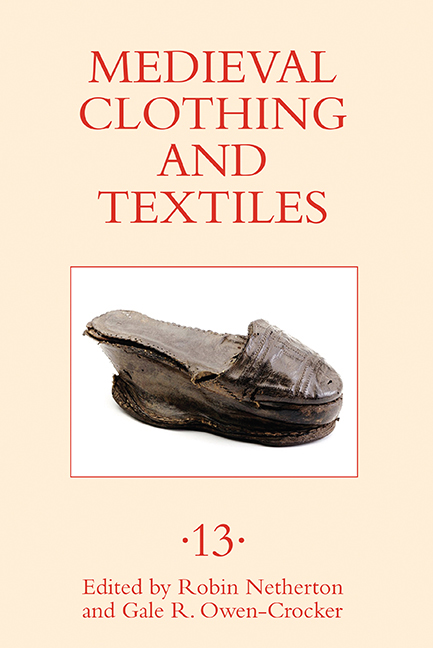Book contents
- Frontmatter
- Contents
- Illustrations
- Tables
- Contributors
- Preface
- 1 The Significance of Dress in the Bayeux Tapestry
- 2 How Long Is a Launce? Units of Measure for Cloth in Late Medieval Britain
- 3 Robes, Turbans, and Beards: “Ethnic Passing” in Decameron 10.9
- 4 Calciamentum: Footwear in Late Medieval Lucca
- 5 “Bene in ordene et bene ornata“: Eleonora d’Aragona’s Description of Her Suite of Rooms in a Roman Palace of the Late Fifteenth Century
- 6 The Lübeck Wappenröcke: Distinctive Style in Fifteenth-Century German Fabric Armor
- Recent Books of Interest
- Contents of Previous Volumes
2 - How Long Is a Launce? Units of Measure for Cloth in Late Medieval Britain
Published online by Cambridge University Press: 12 August 2020
- Frontmatter
- Contents
- Illustrations
- Tables
- Contributors
- Preface
- 1 The Significance of Dress in the Bayeux Tapestry
- 2 How Long Is a Launce? Units of Measure for Cloth in Late Medieval Britain
- 3 Robes, Turbans, and Beards: “Ethnic Passing” in Decameron 10.9
- 4 Calciamentum: Footwear in Late Medieval Lucca
- 5 “Bene in ordene et bene ornata“: Eleonora d’Aragona’s Description of Her Suite of Rooms in a Roman Palace of the Late Fifteenth Century
- 6 The Lübeck Wappenröcke: Distinctive Style in Fifteenth-Century German Fabric Armor
- Recent Books of Interest
- Contents of Previous Volumes
Summary
The record book known as the Liber Custumarum—which forms a large part of the Anglo-Norman records of the London Guildhall (Munimenta Gildhallae Londoniensis) —contains a very interesting reference from ca. 1300 to an apparent measure of cloth, seemingly in the form of a common Gallicism:
Et purveu est qe nul teler ne oevre andley, porreye, ne marbruy de flur de vesz, ne vert en veyr, fors un fil et un; et ceo soit en .vi. launces, issi qe les draps de totes partz … soient bons et loiaux
[And provision is that no weaver shall do work of andley (a type of cloth), porreye (leek-coloured cloth), nor marbruy (marbled cloth) of vetch flowers (ground with vetch blossoms), nor green en vair (perhaps a pattered green cloth—see the discussion below), except un fil et un (“thread and thread”?) and this is to be in 6 launces, so that the cloths in all parts be of good quality and genuine]
The editors of the Anglo-Norman Dictionary contacted us at the Lexis of Cloth and Clothing in Britain project with the hope of shedding some light on this rare technical usage of launce as an apparent unit of measure. The term appears later in the document as well, with less semantic framing.
The quest to identify and contextualise this particular usage has prompted the present study, which uses the resources of the Lexis project database to elucidate lexical items used to name some of the measures of cloth in post-Conquest British documents. It limits itself, for the most part, to the “official” languages of state and bureaucratic record keeping (Latin, Anglo-Norman, and Middle English) and draws data from the various dictionary resources and works on material culture available to the compilers of the Lexis project database. This article attempts to classify, as briefly as possible, some of the primary words for measuring cloth available in official documents from the period and sets out vocabulary by types of material measured, whether numerically prescribed (or not), and by probable source of semantic development (for example: “cloth eponyms”: broad, drap; or, more frequently, “physical object, such as body part, of determined length”: aune/ell/ulna/etc., brace/brachium, foot, launce, etc.).
- Type
- Chapter
- Information
- Medieval Clothing and Textiles 13 , pp. 31 - 66Publisher: Boydell & BrewerPrint publication year: 2017

